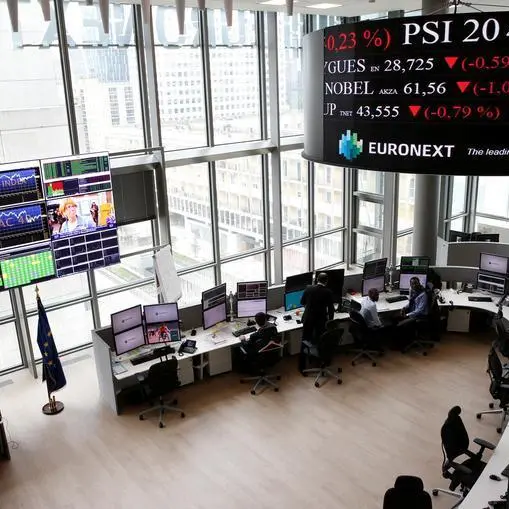PHOTO
WASHINGTON, DC - MARCH 21: The Federal Reserve Headquarters are pictured on March 21, 2023 in Washington, DC. The Federal Open Market Committee is meeting today to decide on a possible interest rate hike in the middle of ongoing banking turmoil after the of failures of Silicon Valley Bank, Signature Bank and Silvergate. Kevin Dietsch/Getty Images/AFP (Photo by Kevin Dietsch / GETTY IMAGES NORTH AMERICA / Getty Images via AFP)
CAMBRIDGE – Consider last week’s tale of two central banks. Each is long-established, with influence that extends well beyond its country’s borders, and both are pressed to make delicate judgment calls aimed at continuing to reduce inflation while avoiding undue damage to growth and jobs. In the event, they end up taking very different approaches within 24 hours of each other.
The first protagonist is the Bank of England, which cuts its policy rate by 25 basis points, following a 5-4 vote that reflects the complexity of the underlying economic issues. The other is the US Federal Reserve, which takes pride in forging a consensus and delivering a unanimous vote, only to get battered by analysts and the media in the days following its decision. Which central bank do you trust more with your economic well-being and that of your family and friends?
This is an important question, because trust underpins a central bank’s ability to fulfill its mandate. Much of today’s financial architecture rests on the assumption that central banks are committed to maintaining public confidence in their policymaking. After all, an inflation target must be credible to anchor inflation expectations; and the same goes for forward guidance that is meant to smooth out the bumpiness of policy adjustments over time.
Trust and credibility are supported by offering greater transparency, a process that has evolved over the years into holding regular press conferences and publishing meeting minutes and transcripts. In some cases, the central bank makes quarterly quantitative projections for major policies and economic metrics.
The credibility of both the BOE and the Fed has been bolstered by good outcomes. But they differ on an important input metric: how to communicate their policy decision-making. The situation reminds me of an old quip about lawyers and economists: Unlike lawyers, who can argue with 100% conviction even when the foundation of their case is very weak, economists need a very strong foundation to argue with much conviction at all.
Having incorporated independent, external members into its Monetary Policy Committee (MPC), the BOE does not hesitate in signaling divisions among its top decision-makers. The recent 5-4 vote in favor of a cut followed a June vote of 7-2 in favor of keeping rates unchanged. And in February, the MPC voted 2-6-1, with two members calling for a hike, six favoring no change, and one supporting a cut. In each case, all the arguments behind these votes were explained in the days and weeks following the MPC’s meeting.
Revealing such a range of individual positions is essentially unheard of at the Fed. While the US central bank prides itself on welcoming a diversity of views during its deliberations behind closed doors, it is also steeped in the tradition of consensus decision-making. Thus, in practice, it maintains very high barriers to publicizing dissenting views. Even the Fed Board minutes that are released three weeks after each meeting tend to gloss over the full array of views that were aired. To find out what was really said, one must wait for the full transcripts, which are typically released five years later.
Don’t get me wrong. There is value in a consensus-based approach that helps reconcile different opinions and analyses. But a fabricated consensus – often pursued for political reasons, or to save face (supposedly) – tends to obfuscate and marginalize views that deserve broader consideration. Coupled with a structural lack of cognitive diversity and a high probability of falling into groupthink, the consensus obsession ultimately undermines the very credibility that the Fed has been trying to restore since its big policy error in 2021.
By refusing to offer the type of decision-making transparency adopted by the BOE, the Fed inadvertently mirrored the complacency of a market that had failed to consider the possibility of a faster- and broader-than-anticipated economic slowdown. As a result, the market reacted violently when a slowdown became apparent, following the release of weaker-than-expected purchasing managers’ index data and the latest monthly employment report, which came in the immediate aftermath of the Fed’s policy meeting.
The market had absorbed Chair Jerome Powell’s repeated assurances (including at the European Central Bank conference in Sintra, Portugal, on July 2) that a “fundamentally healthy” economy and a solid labor market gave the Fed ample time to decide on rate cuts. When new data suggested otherwise, chaos ensued as markets scrambled to raise the probability of an unusually large 50-basis-point cut in September from virtually zero to around 80%, as of August 2. (They have also priced in a faster and higher-magnitude overall rate-cutting cycle.)
This violent reaction brought a dramatic collapse in yields on government bonds and large stock-market losses that, having started in the United States, spread globally and exposed vulnerabilities elsewhere, most notably in Japan. Worries about the heightened risk of financial and economic breakage even led some (though not me) to call for an emergency inter-meeting rate cut.
No, I am not advocating that the Fed adopt the type of radical transparency for which the hedge fund Bridgewater is famous. There are certain areas, such as the quarterly “dot plot” of forecasts, in which the Fed has arguably already gone too far. Still, the Fed could – and should – be more open about the policy decisions that affect us all.
Mohamed A. El-Erian, President of Queens’ College at the University of Cambridge, is a professor at the Wharton School of the University of Pennsylvania and the author of The Only Game in Town: Central Banks, Instability, and Avoiding the Next Collapse (Random House, 2016) and a co-author (with Gordon Brown, Michael Spence, and Reid Lidow) of Permacrisis: A Plan to Fix a Fractured World (Simon & Schuster, 2023).
Copyright: Project Syndicate, 2024.
www.project-syndicate.org





















